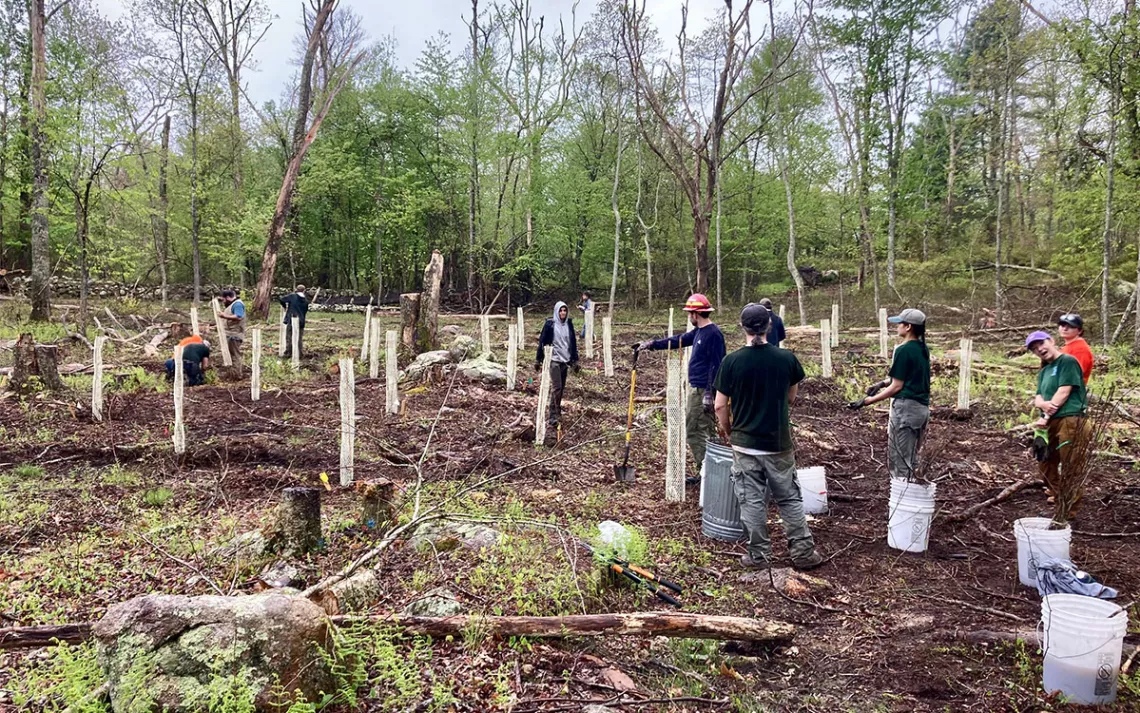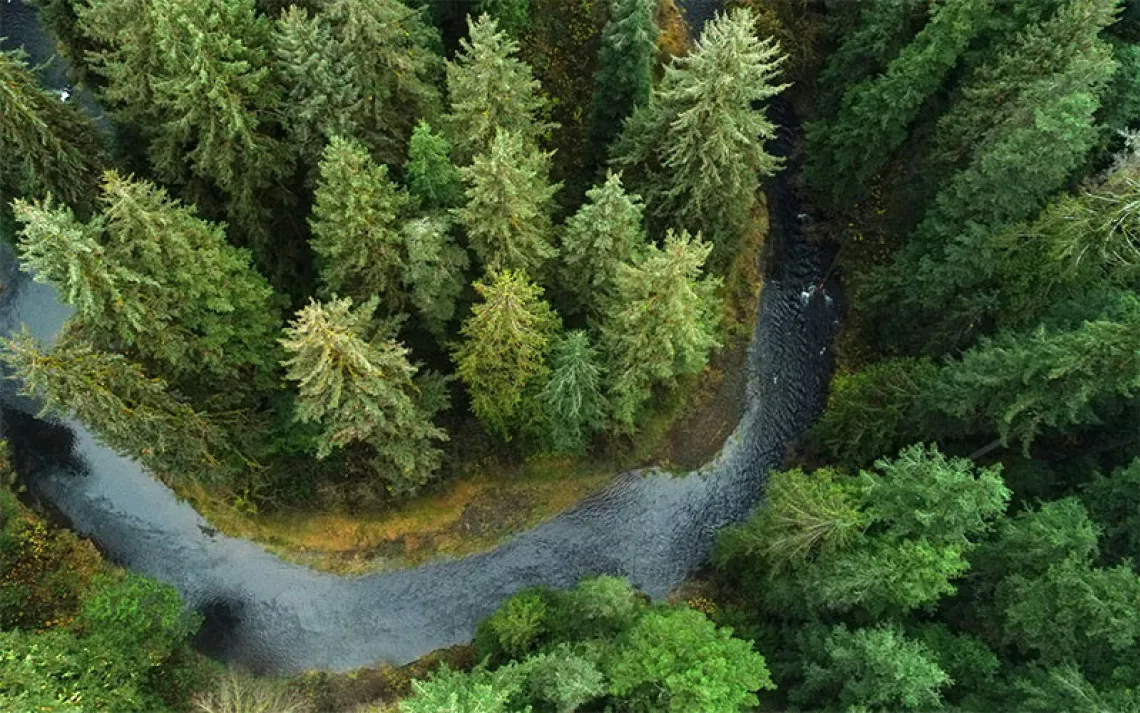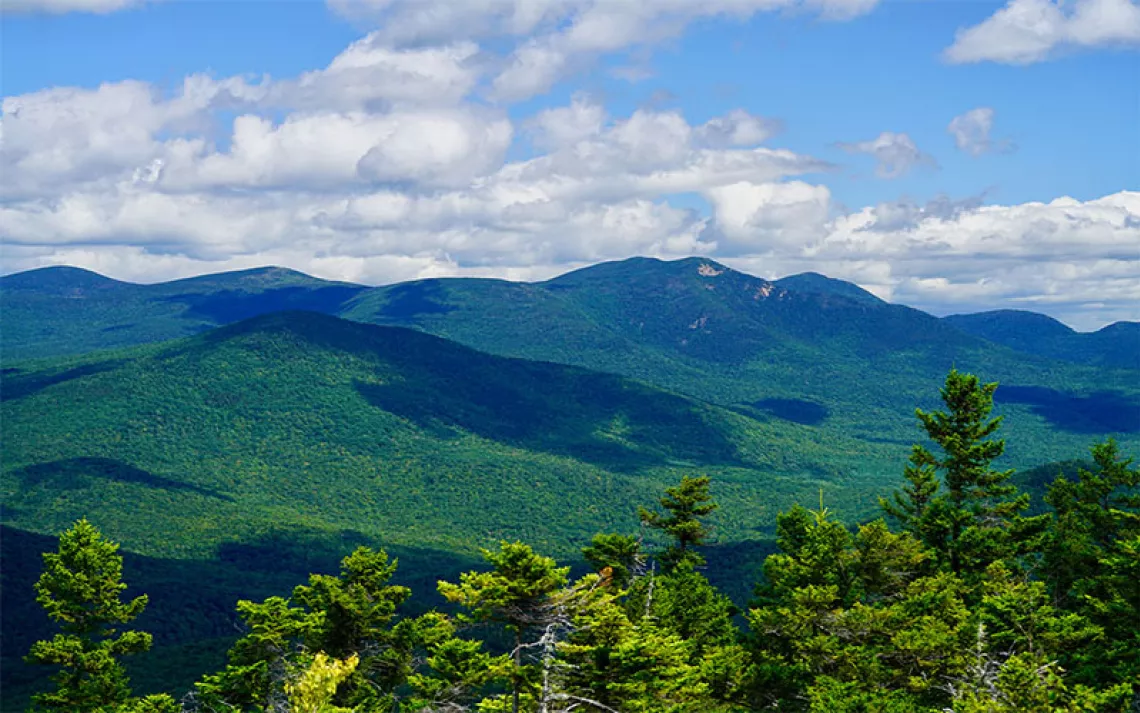Moving Slightly Southern Trees to New England Could Help Forests Survive Climate Change
Silviculture trials explore swapping in trees closely related to northeastern varieties

Tree resilience experimentation at the Hillsdale Preserve replicate site in Connecticut. | Photo by Christopher Riely
Alan Ladd was a blur of safety orange as he rushed into the North Stonington Town Garage one spring morning. “Gotta jot this dead tree down before I forget,” he mumbled as he grabbed a red marker and scanned a huge whiteboard jammed with the locations of dead trees to be removed. He crouched down, looking for space to note the diseased red oak he just observed. “Need a bigger board!” a colleague called out from the break room.
Ladd is the tree warden for North Stonington, Connecticut, a hilly, forested community on the Rhode Island border. He’s tasked with removing trees on public property that pose a danger of falling into the roadway (threats to power lines are handled by the power company). Lately, disease, drought, and pests have made the job unusually busy. Ladd estimates that the town removed more than 200 trees last year, a number that has been growing annually as a host of afflictions proliferate. The emerald ash borer beetle is laying waste to the region’s ash trees, while an infestation of spongy moths has been attacking the oaks, and beech leaf disease is ravaging beech trees. The mighty ash, once the staple of baseball bats and hockey sticks because of its tensile strength, and pounded into fibers used by Indigenous groups for baskets, is estimated to be a total loss throughout New England.
The pests have been around for decades. The emerald ash borer was first detected in Michigan in 2002 and steadily spread east. The spongy moth has been in the US since about 1868, after a Massachusetts entrepreneur brought it here as an experimental silk producer. When the population is small, the moth exists in rough equilibrium with the forest. But when it surges—which happened in Connecticut in the 1970s and '80s, and again recently—it can be devastating to trees.
Climate change has tipped that balance. Recent droughts inhibited both a fungus and a virus that had kept spongy moth caterpillar populations in check, while also weakening the trees’ immune systems, and warmer winters have allowed insect populations to flourish. Driving along a tree-shrouded road, Ladd pointed out his truck window at a stand of gray trunks whose leafless branches clawed at the sky. He took out a pen and marked them down. On his mind is the town’s $20,000 tree-removal budget. “Last year we blew through $20,000 pretty fast,” he recalled.
But a research project by the area’s universities is trying to help by introducing strains of trees that might withstand these challenges.
“What we’ve really been seeing is climate-change-related stress combining with pests and pathogens,” explained Robert Fahey, a forestry professor at the University of Connecticut. In response to the widespread tree loss, UConn, along with neighboring University of Rhode Island, joined the Adaptive Silviculture for Climate Change Network, a collaborative effort in the US and Canada to develop test sites, or “silviculture trials,” across a range of forest ecosystems. In southern New England, the project involves bringing in oaks from slightly southern and western climes, such as New Jersey, Maryland, and Pennsylvania. These trees are closely related to New England’s native oaks but are accustomed to warmer temperatures.
“If we want to continue to enjoy the benefits of our forests, we need to do some kind of management activity to counter these negative influences,” said Fahey’s colleague at UConn, forestry professor Thomas Worthley.
The insects and fungi are just the beginning of the challenge. Once mature trees die, they open the forest floor to sunlight, which allows invasive vegetation to thrive. If left unmanaged, this chokes out saplings. The result was in front of us as we walked through Hillsdale Preserve, a 36-acre site owned by Rhode Island’s Department of Environmental Management and managed by URI. The preserve is dense forest, not far from suburbs and towns, but the understory is lush with the so-called native invasive shrub barberry, which, though from the region, grows aggressively and outcompetes other vegetation. Dead trees, or snags, stand upright in open patches of sunlight where the tree canopy has eroded. UConn manages two of these sites in Connecticut, but the saplings in the URI site are farther along, so Fahey and Worthley arranged to meet URI forestry specialist and research associate Christopher Riely to show me the project. All the sites are organized into four treatment areas: resistance, resilience, transition, and an unmanaged control site.
We entered the preserve on a dirt road leading directly into the resistance treatment area, where researchers are trying to maintain existing conditions by clearing out some of the more common trees and snags so that the shade-intolerant oak saplings can regenerate. The researchers want sunlight to reach the subcanopy but have to manage it to prevent invasive shrubs from overrunning the ground. Up a slight incline along a centuries-old stone wall is the second treatment site: resilience. Here, researchers have planted native saplings of white, black, and scarlet oak, as well as hickory, encased in grow tubes to protect them from nibbling deer. The goal is to create conditions to enhance tree diversity. They are “trying to increase species age and structural diversity with a focus on native species,” said Fahey.
A short distance up the trail, we entered the transition treatment area, where we saw the transplanted saplings from farther south. This is the spot in the forest most impacted by the confluence of drought-stressed soil, pests, invasive plants, and extreme grazing from an abundance of deer. The gaps in the tree canopy are the largest and the soil rocky and fast-draining. A glimpse of the future, perhaps. Here researchers have taken down the snags and cleared the ground cover, then planted cousins of the native oaks. Poking up through the grow tubes are oaks with names less familiar to New Englanders—southern red, chinkapin, bur, and shumard—that have a track record growing in warmer areas. “What we expect is that they will be more heat and drought tolerant,” said Fahey.
The goal of this project is to get some baseline data that can be shared with public and private land managers in the future. “We want to see what kind of regeneration we get, and how the composition of the forest canopy evolves,” Riely said. “Diversity of tree species is the goal.”
The adaptive silviculture experiment is taking place elsewhere across the country, with large sites in Ohio, Minnesota, and New Hampshire, all with the goal of determining if forests can be managed to adapt to climate change. If the imported oaks do, indeed, thrive in southern New England, that’s information land managers, including tree wardens like Ladd, can use to help towns replace diseased tree populations. The results are not expected anytime soon. Trees grow slowly.
While it’s true that southern New England’s trees are struggling, don’t give up on the tough Yankee forests just yet. As UConn’s Worthley noted, after European colonists came to Connecticut, they cleared roughly 80 percent of the tree cover for farming and cattle grazing. But when the region shifted away from agriculture, the forests rebounded. Today, 75 percent of Connecticut is under tree canopy and 60 percent of the state is forest. “We live in a place with a lot of trees,” Worthley said. “People are spread out among the trees. We are part of the forest ecosystem.”
 The Magazine of The Sierra Club
The Magazine of The Sierra Club



